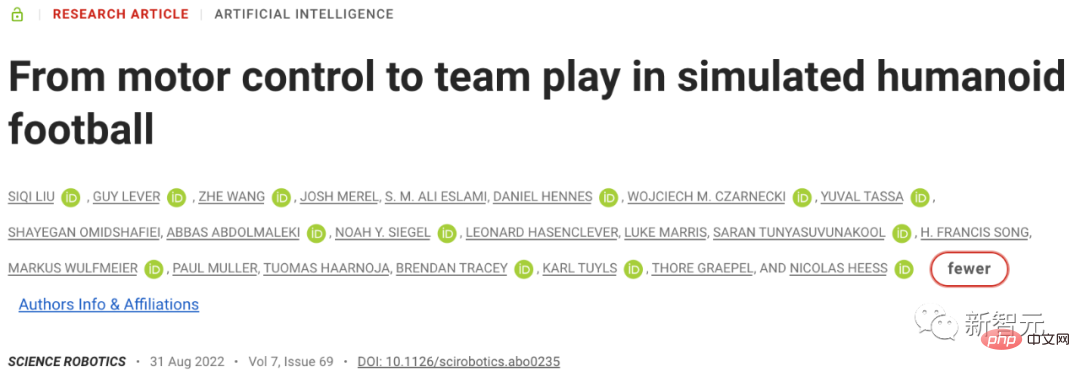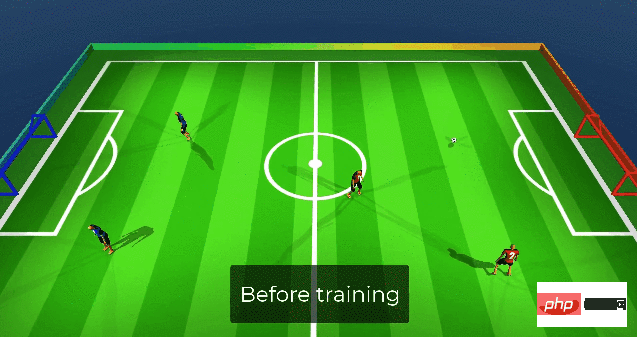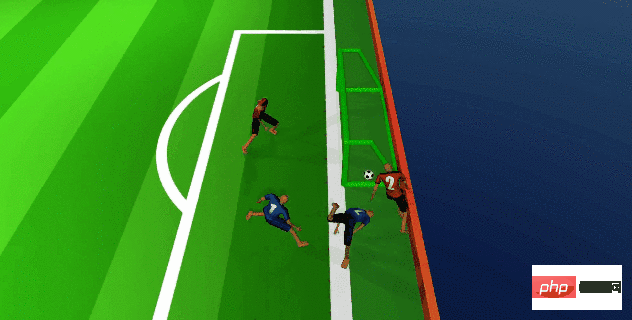AI can 'play football', but AI robots can't yet
In November this year, the World Cup will start again.
At that time, no matter whether we play or not, whether we play well or not, many people will start talking about football again.
No way, who calls football the largest sport in the world.
However, compared to the World Cup, scientists are more interested in the Annual Robot Cup 3D Simulation League.
Not long ago, a research team from the British artificial intelligence company DeepMind used an accelerated version of the sports course to simulate decades of football matches through computers to train the AI to learn how to skillfully Control digital humanoid football players.

Relevant research was published in the journal Science Robotics.

Paper address: https://www.science.org/doi/10.1126/scirobotics.abo0235
Obviously, this is not the first time that “AI football players” have entered the public eye.
A Brief History of the Evolution of AI Football Players
As early as 2016, not long after AlphaGo defeated Lee Sedol in Go, Deepmind began to ponder Let AI play football.
In June of that year, DeepMind researchers asked AI to control an ant-shaped object to chase the ball, and then dribble the ball until it was sent to the goal to score.
According to David Silver, the leader of the DeepMind team, with the help of Google’s newly developed asynchronous Actor-Critic algorithm, namely A3C, AI not only completed the project, but also continued to use it throughout the entire process. He needs to be taught about mechanics.
This experiment gave “AI Football Playing” a good start.
By 2019, DeepMind has trained many "Players", which are made from different training plans. DeepMind selected 10 two-person football teams from them.
Each of these 10 teams has 25 billion frames of learning experience, and DeepMind collected 1 million games between them.
Then DeepMind sets up the environment to let multiple AIs play football games together, and sets the rules in advance to reward the entire "football team" instead of encouraging an individual "AI player" results to promote the progress of the entire team.
DeepMind has proven in this way that AI can cooperate with each other.

It seemed that everything was going well, but in 2020, DeepMind's AI players had problems.
According to the information provided by Brain JiTi, during a game, one side’s football robots lined up in a row to shoot at the goal, but the robot goalkeeper was not prepared to defend. He fell to the ground and began to swing his legs wildly.
Do you think this is over? Too naive!
Then the forward robot player did a very confusing dance, stomping his feet, waving his hands, and fell to the ground with a thud.
This scene shocked the audience: they have seen people letting loose, but they have never seen people letting loose like this!
Why is this happening?
This also starts with the principle behind it.
At the beginning of "AI Playing Football", researchers adopted the path of reinforcement learning.
Previously, AlphaGo’s learning was based on supervised learning, that is, training through labeled data sets.
But this method has high requirements on the "cleanness" of the data: once there is a problem with the data, the AI will make mistakes.
In contrast, reinforcement learning imitates the human learning model. AI learns in a "trial and error" manner. It is rewarded when it is right and punished when it is wrong, thereby establishing the correct connection. .
It seems to be much smarter than traditional supervised learning, but it still has loopholes.
For example, AI will have a wrong understanding of rewards and punishments, thus generating strange strategies.
OpenAI once designed a rowing game. The original task of the AI was to complete the race.
The researchers set up two rewards, one is to complete the game, and the other is to collect scores in the environment. The result is that the agent found an area and kept spinning around there to "get points". In the end, it naturally failed to complete the game, but its score was higher.

According to the paper description, although the DeepMind team simplified the game rules in this study and limited the number of players in the two teams to 2-3, the "AI football players" can complete breakthroughs with the ball, physical confrontation, and precision Shooting and other actions.
So how do researchers train “AI football players”?
Simply put, it combines supervised learning and reinforcement learning.
In the first step, the AI needs to watch video clips of humans playing football and learn to walk naturally, because the AI does not know what to do on the football field at first.

In the second step, the AI practices dribbling and shooting under the reinforcement learning algorithm.
AI can complete these two steps in about 24 hours.
The third step is to train in the form of a competition. The AI robot conducts a 2-on-2 competition. This step takes 2 to 3 weeks, mainly to let the AI learn teamwork. and more difficult motion control such as predicting passes.

The performance of the “AI football player” this time still made the research team feel quite satisfied.
The DeepMind team believes that this research promotes the advancement of artificial systems towards human-level motor intelligence.
However, the DeepMind team is still relatively sober. They know that this breakthrough still has limitations.
For example, the game is 2v2 instead of the 11v11 commonly used in real football matches. This does not mean that AI can participate in more complex football matches.
In addition, even a simple 2v2 match cannot be used directly on robot hardware.
In other words, scientists have not yet been able to develop a robot that can play football.
Reference: https://www.science.org/doi/10.1126/scirobotics.abo0235
https://sports.yahoo.com/deepmind- ai-now-play-football-134345563.html?guccounter=2
https://www.woshipm.com/ai/3619952.htmlhttp://it.people.com.cn/n1/2016 /0622/c1009-28467916.html
The above is the detailed content of AI can 'play football', but AI robots can't yet. For more information, please follow other related articles on the PHP Chinese website!

Hot AI Tools

Undresser.AI Undress
AI-powered app for creating realistic nude photos

AI Clothes Remover
Online AI tool for removing clothes from photos.

Undress AI Tool
Undress images for free

Clothoff.io
AI clothes remover

AI Hentai Generator
Generate AI Hentai for free.

Hot Article

Hot Tools

Notepad++7.3.1
Easy-to-use and free code editor

SublimeText3 Chinese version
Chinese version, very easy to use

Zend Studio 13.0.1
Powerful PHP integrated development environment

Dreamweaver CS6
Visual web development tools

SublimeText3 Mac version
God-level code editing software (SublimeText3)

Hot Topics
 Bytedance Cutting launches SVIP super membership: 499 yuan for continuous annual subscription, providing a variety of AI functions
Jun 28, 2024 am 03:51 AM
Bytedance Cutting launches SVIP super membership: 499 yuan for continuous annual subscription, providing a variety of AI functions
Jun 28, 2024 am 03:51 AM
This site reported on June 27 that Jianying is a video editing software developed by FaceMeng Technology, a subsidiary of ByteDance. It relies on the Douyin platform and basically produces short video content for users of the platform. It is compatible with iOS, Android, and Windows. , MacOS and other operating systems. Jianying officially announced the upgrade of its membership system and launched a new SVIP, which includes a variety of AI black technologies, such as intelligent translation, intelligent highlighting, intelligent packaging, digital human synthesis, etc. In terms of price, the monthly fee for clipping SVIP is 79 yuan, the annual fee is 599 yuan (note on this site: equivalent to 49.9 yuan per month), the continuous monthly subscription is 59 yuan per month, and the continuous annual subscription is 499 yuan per year (equivalent to 41.6 yuan per month) . In addition, the cut official also stated that in order to improve the user experience, those who have subscribed to the original VIP
 Context-augmented AI coding assistant using Rag and Sem-Rag
Jun 10, 2024 am 11:08 AM
Context-augmented AI coding assistant using Rag and Sem-Rag
Jun 10, 2024 am 11:08 AM
Improve developer productivity, efficiency, and accuracy by incorporating retrieval-enhanced generation and semantic memory into AI coding assistants. Translated from EnhancingAICodingAssistantswithContextUsingRAGandSEM-RAG, author JanakiramMSV. While basic AI programming assistants are naturally helpful, they often fail to provide the most relevant and correct code suggestions because they rely on a general understanding of the software language and the most common patterns of writing software. The code generated by these coding assistants is suitable for solving the problems they are responsible for solving, but often does not conform to the coding standards, conventions and styles of the individual teams. This often results in suggestions that need to be modified or refined in order for the code to be accepted into the application
 Seven Cool GenAI & LLM Technical Interview Questions
Jun 07, 2024 am 10:06 AM
Seven Cool GenAI & LLM Technical Interview Questions
Jun 07, 2024 am 10:06 AM
To learn more about AIGC, please visit: 51CTOAI.x Community https://www.51cto.com/aigc/Translator|Jingyan Reviewer|Chonglou is different from the traditional question bank that can be seen everywhere on the Internet. These questions It requires thinking outside the box. Large Language Models (LLMs) are increasingly important in the fields of data science, generative artificial intelligence (GenAI), and artificial intelligence. These complex algorithms enhance human skills and drive efficiency and innovation in many industries, becoming the key for companies to remain competitive. LLM has a wide range of applications. It can be used in fields such as natural language processing, text generation, speech recognition and recommendation systems. By learning from large amounts of data, LLM is able to generate text
 Can fine-tuning really allow LLM to learn new things: introducing new knowledge may make the model produce more hallucinations
Jun 11, 2024 pm 03:57 PM
Can fine-tuning really allow LLM to learn new things: introducing new knowledge may make the model produce more hallucinations
Jun 11, 2024 pm 03:57 PM
Large Language Models (LLMs) are trained on huge text databases, where they acquire large amounts of real-world knowledge. This knowledge is embedded into their parameters and can then be used when needed. The knowledge of these models is "reified" at the end of training. At the end of pre-training, the model actually stops learning. Align or fine-tune the model to learn how to leverage this knowledge and respond more naturally to user questions. But sometimes model knowledge is not enough, and although the model can access external content through RAG, it is considered beneficial to adapt the model to new domains through fine-tuning. This fine-tuning is performed using input from human annotators or other LLM creations, where the model encounters additional real-world knowledge and integrates it
 To provide a new scientific and complex question answering benchmark and evaluation system for large models, UNSW, Argonne, University of Chicago and other institutions jointly launched the SciQAG framework
Jul 25, 2024 am 06:42 AM
To provide a new scientific and complex question answering benchmark and evaluation system for large models, UNSW, Argonne, University of Chicago and other institutions jointly launched the SciQAG framework
Jul 25, 2024 am 06:42 AM
Editor |ScienceAI Question Answering (QA) data set plays a vital role in promoting natural language processing (NLP) research. High-quality QA data sets can not only be used to fine-tune models, but also effectively evaluate the capabilities of large language models (LLM), especially the ability to understand and reason about scientific knowledge. Although there are currently many scientific QA data sets covering medicine, chemistry, biology and other fields, these data sets still have some shortcomings. First, the data form is relatively simple, most of which are multiple-choice questions. They are easy to evaluate, but limit the model's answer selection range and cannot fully test the model's ability to answer scientific questions. In contrast, open-ended Q&A
 SOTA performance, Xiamen multi-modal protein-ligand affinity prediction AI method, combines molecular surface information for the first time
Jul 17, 2024 pm 06:37 PM
SOTA performance, Xiamen multi-modal protein-ligand affinity prediction AI method, combines molecular surface information for the first time
Jul 17, 2024 pm 06:37 PM
Editor | KX In the field of drug research and development, accurately and effectively predicting the binding affinity of proteins and ligands is crucial for drug screening and optimization. However, current studies do not take into account the important role of molecular surface information in protein-ligand interactions. Based on this, researchers from Xiamen University proposed a novel multi-modal feature extraction (MFE) framework, which for the first time combines information on protein surface, 3D structure and sequence, and uses a cross-attention mechanism to compare different modalities. feature alignment. Experimental results demonstrate that this method achieves state-of-the-art performance in predicting protein-ligand binding affinities. Furthermore, ablation studies demonstrate the effectiveness and necessity of protein surface information and multimodal feature alignment within this framework. Related research begins with "S
 Five schools of machine learning you don't know about
Jun 05, 2024 pm 08:51 PM
Five schools of machine learning you don't know about
Jun 05, 2024 pm 08:51 PM
Machine learning is an important branch of artificial intelligence that gives computers the ability to learn from data and improve their capabilities without being explicitly programmed. Machine learning has a wide range of applications in various fields, from image recognition and natural language processing to recommendation systems and fraud detection, and it is changing the way we live. There are many different methods and theories in the field of machine learning, among which the five most influential methods are called the "Five Schools of Machine Learning". The five major schools are the symbolic school, the connectionist school, the evolutionary school, the Bayesian school and the analogy school. 1. Symbolism, also known as symbolism, emphasizes the use of symbols for logical reasoning and expression of knowledge. This school of thought believes that learning is a process of reverse deduction, through existing
 SK Hynix will display new AI-related products on August 6: 12-layer HBM3E, 321-high NAND, etc.
Aug 01, 2024 pm 09:40 PM
SK Hynix will display new AI-related products on August 6: 12-layer HBM3E, 321-high NAND, etc.
Aug 01, 2024 pm 09:40 PM
According to news from this site on August 1, SK Hynix released a blog post today (August 1), announcing that it will attend the Global Semiconductor Memory Summit FMS2024 to be held in Santa Clara, California, USA from August 6 to 8, showcasing many new technologies. generation product. Introduction to the Future Memory and Storage Summit (FutureMemoryandStorage), formerly the Flash Memory Summit (FlashMemorySummit) mainly for NAND suppliers, in the context of increasing attention to artificial intelligence technology, this year was renamed the Future Memory and Storage Summit (FutureMemoryandStorage) to invite DRAM and storage vendors and many more players. New product SK hynix launched last year






